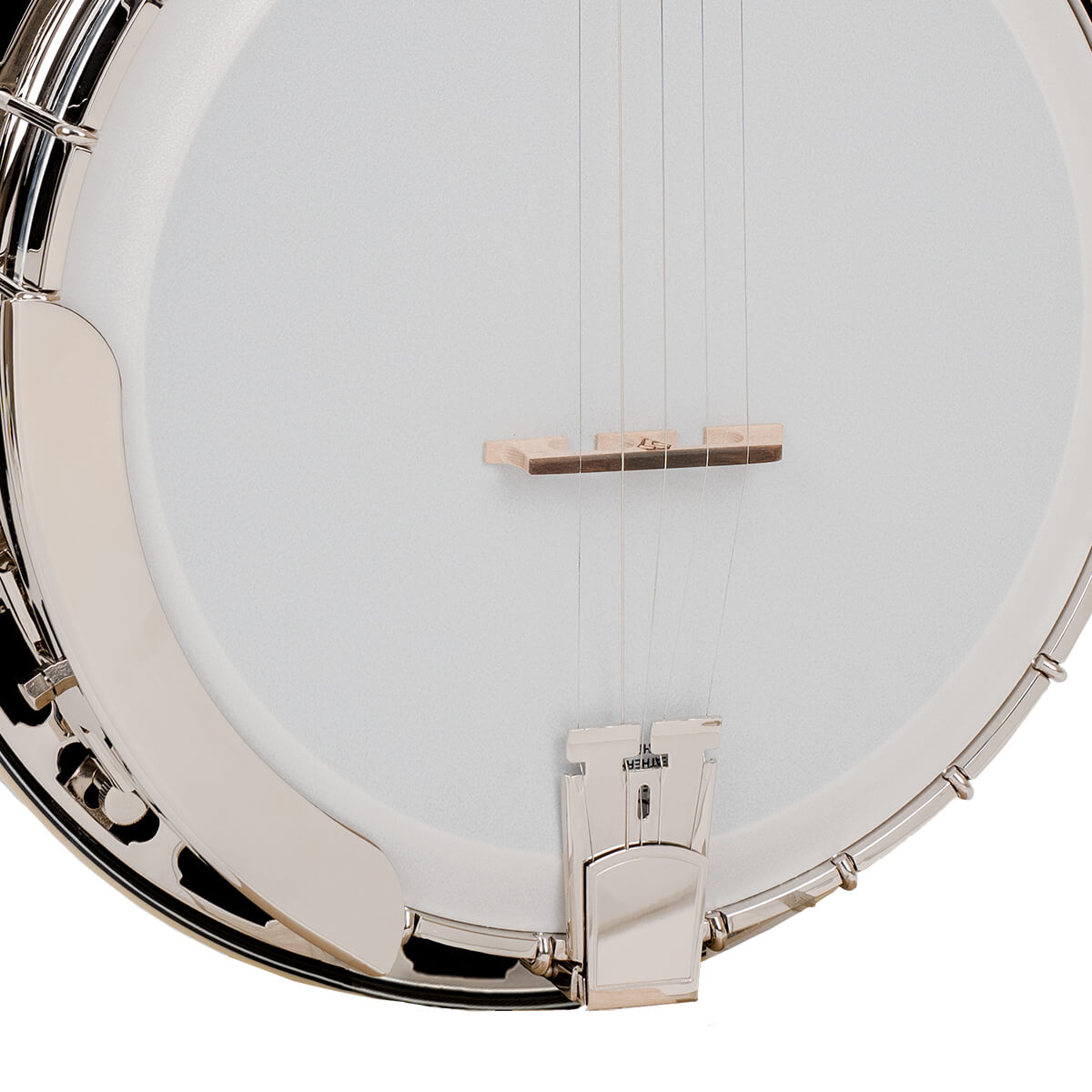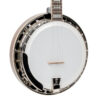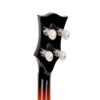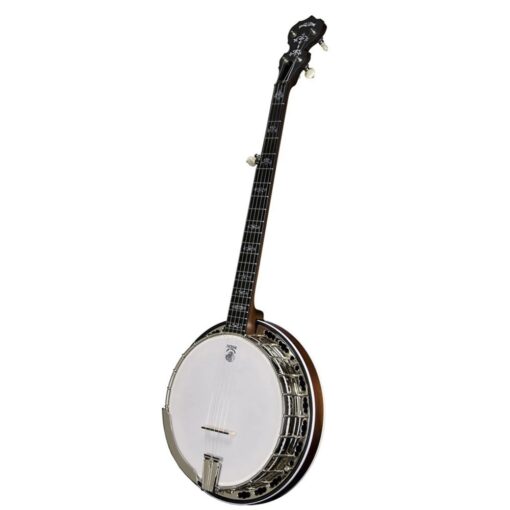NEW Goldtone MastertoneTM OB-2AT: Archtop Bowtie Banjo
$ 1,799.00
Mahogany neck and maple resonator, a beautiful golden sunburst finish and even a nineteen-hole flathead tone ring, now available in Archtop. Updated features include superb quality Gotoh machine heads, the renowned Snuffy Smith bridge, a Presto-style tailpiece and dual coordinator rods for precise adjustment.
In stock
From Gold Tone Representative, Marc Horowitz:
“In 1963, I was a junior in high school. I was consumed then (as now) with all things banjo. I was playing a Seeger-style longneck Bacon banjo, but I’d recently become aware that what I needed for Bluegrass was a MASTERTONE. In those days, there was no “vintage” craze; the banjos from the 1930s (only thirty years before) were just, well… used banjos. Some players had one, some didn’t. Many of the big Bluegrass names (Scruggs, Reno, Crowe etc.) had pre-war banjos, but some others (Alan Shelton for example) played a contemporary bowtie banjo.
I decided that THAT’S what I would get. My father liberated some of my bar mitzvah money and off I went to Roger Sprung’s place to buy a bowtie Mastertone. I was over the moon! I practiced hard and made the rapid progress you achieve when you acquire a professional-grade instrument. While this was going on, the mystique of the “pre-war” Mastertones was coming onto every picker’s radar. Suddenly, EVERYONE wanted a nineteen-thirties banjo! The race was on, and I fell for the legend. When a friend offered to sell me his 1926 RB-5, I made it happen; I sold the bowtie.
Fast forward to around ten years ago. I was musing one day about all of the banjos that had passed through my hands over the previous four decades. I fondly remembered that first Mastertone bowtie I had bought new in 1963. I wondered what I would think of one of those now, if I found one. I’d learned a lot about banjo setup over the past forty years. Maybe I could get one of these and optimized it for today’s styles of playing.
It’s worth mentioning that while a pre-war banjo was thirty to forty years old back in the sixties, a bowtie Mastertone from ’63 is now SIXTY years old! I located a mint condition ’63 and bought it. After I finished setting it up it was… WOW. I still have it. I found more examples and bought, fixed up and resold them to eager buyers. Today, a clean early sixties bowtie brings five to six thousand dollars, and they sell quickly. These are great banjos.
Since the success of Gold Tone’s OB-3 Twanger, we were kicking around ideas for the next tribute banjo when the bowtie banjos of 1960 to mid-1964 were brought up. This was when the bowtie was at its peak of quality. A unique nineteen-hole flathead tone ring (versus the previous twenty-hole version) was used during this time. The banjos were built in Kalamazoo by some of the same people that worked there in the thirties, and the tone rings were still cast by the same foundry that made them back before The War. A full thickness rim and nickel-plated hardware were still used as well.
With those specs in mind, we set about creating a worthy modern evocation of this great old banjo: the Gold Tone OB-2 Bowtie. The feature set closely adheres to the original banjo: mahogany neck and maple resonator, a beautiful golden sunburst finish and even a nineteen-hole flathead tone ring, now available in Archtop. Updated features include superb quality Gotoh machine heads, the renowned Dotson bridge, a Presto-style tailpiece and dual coordinator rods for precise adjustment.
From our hands to yours, the value is superb and the tone and playability are amazing. Enjoy!”
Headstock
Neck
Body
Dimensions
Other
Call Geoff for an in-hand description (or to just talk about banjos): 404-218-8580
Email: [email protected]
Follow and subscribe to us on Facebook
Find us on eBay
Find us on Reverb
Watch us on Youtube
To learn about our latest deals, subscribe to our periodic email newsletter.
Call Geoff to schedule an appointment to visit our Atlanta, GA, or Yellow Springs, OH locations.
Geoff also teaches lessons based on his best-selling beginning Banjo book, The Banjo Primer. Buy yourself a copy today or call Geoff to schedule in-person or virtual lessons!
Geoff Hohwald has been playing banjo since the 1960s. As a teenager, he quickly became active in the industrial-strength bluegrass community in Ohio, playing with Red Allen, Sandy Rothman, Sid Campbell, Dave Evans, Frank Wakefield, Hylo Brown, Buddy Thomas, The Fields Brothers, Landon Messer, Earl Taylor, and Brian Aldrige. and has played with several bands ever since.
Related products
Deering's most popular professional grade banjo for almost 30 years. Deering is proud to manufacture the Sierra as affordably as possible and still retain all high-end features that affect the tone and playability.
"Pre-war" style, at a price anyone can afford, AND authentic tone and superb playability describe the OB-150.
Professional Quality Bluegrass Power at an Affordable Price. Includes Upgraded Radius Fretboard and Hardshell Case.
Condition (see photos): Virtually no fret ware. Resonator has some wood checking that is apparent when you shine it under bright light. This RB-250 comes with a high-quality case that somebody wrote "The Gibson" on. However, it is not an original Gibson case.
This variant of the venerable CC-100R features a generous nut width of 1 and 5/16" (1/8" wider than that of standard Cripple Creek models). The rolled brass tone ring and the tension hoop are thicker than those previously used, increasing the mass of the pot assembly. This results in a more powerful sound.
This 1989 Rich-Era Gibson RB-3 Five-String Resonator Banjo sounds phenomenal. It has non-original, but upgraded keys. As an added bonus, it comes with an original Gibson case. Condition: This 1989 Gibson RB-3 has virtually no fret wear. The resonator has some wood checking (which is normal from banjos of this era) and minor scratches (see [...]
Left-handed Mastertone™ OT-800: Old Time Tubaphone-Style Banjo with Case The Old Tone OT-800 pays homage to one of the most sought-after banjos of the “classic” period (1890 to 1930) when the Boston School of banjo making was the highest expression of the art. The pot sports a pre-WW II-style Tubaphone tone ring, which adds pleasing [...]
This 1997 Gibson RB 4 Walnut Five-String Resonator Banjo is in excellent condition. It has a Flying-Eagle inlay and comes with a new Steve Huber bridge and head, and It was set up at the Huber Banjo factory in Nashville, Tennessee.

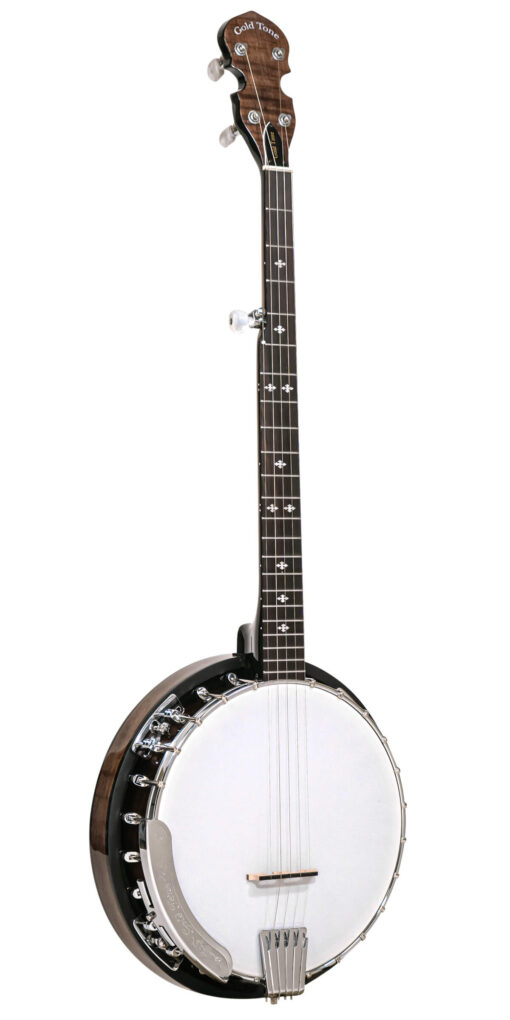 NEW FLOOR MODEL CC-100R+: Cripple Creek Resonator Banjo Upgraded with Pickup
NEW FLOOR MODEL CC-100R+: Cripple Creek Resonator Banjo Upgraded with Pickup 

